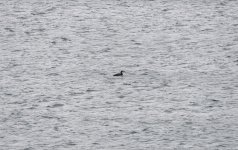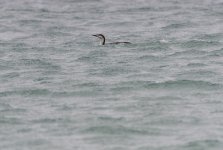-
Welcome to BirdForum, the internet's largest birding community with thousands of members from all over the world. The forums are dedicated to wild birds, birding, binoculars and equipment and all that goes with it.
Please register for an account to take part in the discussions in the forum, post your pictures in the gallery and more.
You are using an out of date browser. It may not display this or other websites correctly.
You should upgrade or use an alternative browser.
You should upgrade or use an alternative browser.
Diver ID please? (1 Viewer)
- Thread starter Scozmos
- Start date
More options
Who Replied?
The first one is certainly a Great Northern Diver.
Scozmos
Well-known member

From memory they're the same bird Andrew, cheers I wasn't sure of this oneThe first one is certainly a Great Northern Diver.
It has the classic features: especially head shape + lower neck pattern. Your field guide will illustrate this.I wasn't sure of this one
Scozmos
Well-known member

This time, a classic red-throated diver: bill shape, head posture, neck pattern.
My views on field guides for beginners (viz. get a nice simple one, RSPB or BTO or whatever's currently good and doesn't use photos) differ from most people's - so I will just let them give their usual advice... But, yes, a field guide is an absolute essential for learning bird ID.
My views on field guides for beginners (viz. get a nice simple one, RSPB or BTO or whatever's currently good and doesn't use photos) differ from most people's - so I will just let them give their usual advice... But, yes, a field guide is an absolute essential for learning bird ID.
foresttwitcher
Virtually unknown member

OK, I'll take the bait and recommend Collins Bird Guide (Lars Svensson)...
kb57
Well-known member

I partly agree with Butty here. If we are talking about starting out birding, and you're based in the British Isles, then RSPB Handbook of British Birds has a lot of information about everything you're likely to see, and quite a few that you aren't. Collins is an excellent guide if you are likely to be travelling in Europe, but covers a much wider range of species, and could therefore be a bit overwhelming.
Where I differ from Butty is I think photo guides have improved a lot as an ID tool, and are also now being packaged as serious field guides. Following the same logic as above, I'd recommend Britain's Birds (Hume et al; Wildguides) for a more in-depth treatment (including most rarities you're ever (un)likely to encounter), and Europe's Birds for a more comprehensive treatment if you're planning on travelling. They're physically quite large and heavy books though, the RSPB Handbook is more practical for field use.
I'm not a big fan of online field guides, the paper versions remain much more practical, but the eBird and Merlin apps are a different matter. eBird will give you a list of species seen around your current location, while the Merlin sound ID and photo ID work pretty well.
Where I differ from Butty is I think photo guides have improved a lot as an ID tool, and are also now being packaged as serious field guides. Following the same logic as above, I'd recommend Britain's Birds (Hume et al; Wildguides) for a more in-depth treatment (including most rarities you're ever (un)likely to encounter), and Europe's Birds for a more comprehensive treatment if you're planning on travelling. They're physically quite large and heavy books though, the RSPB Handbook is more practical for field use.
I'm not a big fan of online field guides, the paper versions remain much more practical, but the eBird and Merlin apps are a different matter. eBird will give you a list of species seen around your current location, while the Merlin sound ID and photo ID work pretty well.
It could just be the angle but the bill shape and gently sloping firehead of the second picture looks more like red-throated to me (i.e. not the same bird)From memory they're the same bird Andrew, cheers I wasn't sure of this one
Stonefaction
Dundee Birding....(target 150 in 2024).

I agree to some extent that Collins is 'too much' field guide for UK birding alone (though the app does let you filter by location - though I did find a few errors when I tried that). The Merlin app can be used as a field guide of sorts (you can filter by birds likely in your location) - and you can try to ID birds with it in 3 ways - answering questions (location/activity/colours etc), sound ID and photo ID, but if you want a book solely for UK birds then the Wildguides "British Birds - A Pocket Guide" has a lot going for it (including the price). I do have a stack of older fieldguides surplus to requirements that some may/may not be of interest though most of the 'best' ones have gone already (PM me if they might be of interest, Brian).
Technically, yes, it does - but it's an oft-repeated myth (or at least the usual implication is mythical) that setting this 'filter' then leaves the app functioning as a field guide restricted to a specific region. It does not do this: it's just a search filter - it does not reset the app's coverage and leave it like that until it's re-reset. In other words, it's terribly clunky and inadequate - as are so many other aspects of this poorly-constructed and under-featured app.the app does let you filter by location - though I did find a few errors when I tried that

Talking about Merlin or Collins?Technically, yes, it does - but it's an oft-repeated myth (or at least the usual implication is mythical) that setting this 'filter' then leaves the app functioning as a field guide restricted to a specific region. It does not do this: it's just a search filter - it does not reset the app's coverage and leave it like that until it's re-reset. In other words, it's terribly clunky and inadequate - as are so many other aspects of this poorly-constructed and under-featured app.
Stonefaction
Dundee Birding....(target 150 in 2024).

You don't need a signal for an app that is installed on your phone (unless you are uploading location or similar). The Collins app has all the info on the species that the book has - with the addition of Status in GB and Ireland and more importantly recordings of songs/calls for most birds that you can listen to, rather than just try to translate someone's phonetic impression of them. It also lets you compare birds side by side, something slightly trickier to do with a paper fieldguide, and you can filter . I prefer a book too, but having the app on my phone - which I'm carrying with me anyway, saves on weight/space in already rather full bag, for those rare ocassions when I do actually need it - though given I spend most of my birding in Dundee that isn't very often.i dont use birding apps, im quite able to id birds myself without the use of algoritiums or whatever they are! field guides love them, require no signal and more info
though i do like gulls research website but not updated often
as for the divers gnd and rtd
Having just read your post, I went into the Settings on the Collins app and set the app to show species for Scotland only - then I turned off my phone and re-opened the app when I switched the phone back on. It is still only showing the Scotland only species. (There are species missing that I think should be in there for Scotland only, but it does actually appear to leave the app as a specific region fieldguide, despite your assertion that it doesn't). The app isn't perfect but it weighs a lot less than the paper copy and I always have my phone with me when birding anyway, so I find it better to have than not to, though I rarely have any cause to use it.Technically, yes, it does - but it's an oft-repeated myth (or at least the usual implication is mythical) that setting this 'filter' then leaves the app functioning as a field guide restricted to a specific region. It does not do this: it's just a search filter - it does not reset the app's coverage and leave it like that until it's re-reset. In other words, it's terribly clunky and inadequate - as are so many other aspects of this poorly-constructed and under-featured app.

Filters on both the Collins app and Merlin work perfectly well for me too - for example, I can set Baltic States for Collins and Lithuania for Merlin, they remain there when I open the app next time.
My comment was quoting someone who was talking about Collins - hence I was too. I apologise for not making that more clear.Talking about Merlin or Collins?
Is this iOS? The Android version (phone - no idea about tablets) doesn't let you do this (I've never heard that iOS does either?). A side-by-side 'compare' function should be a key and added-value feature of an app: the Android phone app has a clunky switch-between-screens compare, but no side-by-side capability; it was improved slightly for edn 3, but it's still clunky and inconvenient to the point of (I find) being of minimal use. It's easier (I find) to compare species using the book.It also lets you compare birds side by side, something slightly trickier to do with a paper fieldguide
Again... Is this iOS? The Android version doesn't work this way. In Android it's not in Settings - you get it from: Search bar > Filter icon > Location and Season - and after that it's like any other search filter, viz. you can lose it altogether if you inadvertently hit Back at the wrong moment, and if you close the app and remove it from the recent-apps list (as one commonly does, both to keep the list usable and to reduce processor/memory overheads) all filters (including location) are lost. Moreover, setting the location filter just gives you a big continuous list of all species - no family grouping - so you lose the ability to whizz thru families before descending to species level.I went into the Settings on the Collins app and set the app to show species for Scotland only - then I turned off my phone and re-opened the app when I switched the phone back on. It is still only showing the Scotland only species

I can do both of those on Android. The compare is very simple and brings species together on a single screen. The location stays set even if I leave the app and return later, but I do lose the ability to open in family groups (I have no use for the location filter anyhow, so no issue for me)Is this iOS? The Android version (phone - no idea about tablets) doesn't let you do this (I've never heard that iOS does either?). A side-by-side 'compare' function should be a key and added-value feature of an app: the Android phone app has a clunky switch-between-screens compare, but no side-by-side capability; it was improved slightly for edn 3, but it's still clunky and inconvenient to the point of (I find) being of minimal use. It's easier (I find) to compare species using the book.
Again... Is this iOS? The Android version doesn't work this way. In Android it's not in Settings - you get it from: Search bar > Filter icon > Location and Season - and after that it's like any other search filter, viz. you can lose it altogether if you inadvertently hit Back at the wrong moment, and if you close the app and remove it from the recent-apps list (as one commonly does, both to keep the list usable and to reduce processor/memory overheads) all filters (including location) are lost. Moreover, setting the location filter just gives you a big continuous list of all species - no family grouping - so you lose the ability to whizz thru families before descending to species level.
Last edited:
Stonefaction
Dundee Birding....(target 150 in 2024).

It was iOS, but I see Jos has commented with regards Android in the intervening period. I believe one of the main issue with regards Android apps (in general) is that they do not work on a 'standard' operating system (unlike the very rigid iOS), so what works on a Samsung, might not work exactly the same on a Huawei (or whatever), and can be a bit of a nightmare for app developers, compared to iOS.My comment was quoting someone who was talking about Collins - hence I was too. I apologise for not making that more clear.
Is this iOS? The Android version (phone - no idea about tablets) doesn't let you do this (I've never heard that iOS does either?). A side-by-side 'compare' function should be a key and added-value feature of an app: the Android phone app has a clunky switch-between-screens compare, but no side-by-side capability; it was improved slightly for edn 3, but it's still clunky and inconvenient to the point of (I find) being of minimal use. It's easier (I find) to compare species using the book.
Again... Is this iOS? The Android version doesn't work this way. In Android it's not in Settings - you get it from: Search bar > Filter icon > Location and Season - and after that it's like any other search filter, viz. you can lose it altogether if you inadvertently hit Back at the wrong moment, and if you close the app and remove it from the recent-apps list (as one commonly does, both to keep the list usable and to reduce processor/memory overheads) all filters (including location) are lost. Moreover, setting the location filter just gives you a big continuous list of all species - no family grouping - so you lose the ability to whizz thru families before descending to species level.
(Numbers 1, 2 & 10 in this list probably explains the difficulties better than I can - 10 Most Common Challenges in Android App Development).
Harrybongo
Well-known member

Hi. I use the Collins 2nd ed - excellent illustrations and text, also, Rspb British birds 2nd ed, both are excellent guides... If l was just starting out, I'd get one of each. 👍
Users who are viewing this thread
Total: 2 (members: 0, guests: 2)








